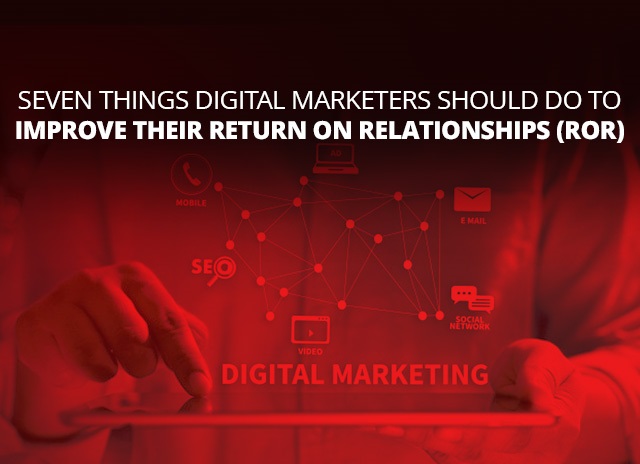Loyalty, sharing, and recommendations represent relationships. The returns from such relationships are far better than what money can bring. In today’s day and age social media is becoming a way of life for people and a way of business for companies who have realized the importance of it, especially for their marketing efforts. To be able to reach the target audience, companies need to focus their marketing efforts on building relationships and expand their metrics beyond Return on Investment to include Return on Relationship.
So, what is ‘Return on Relationships’? According to marketing strategist Ted Rubin, “ROR is the value you accrue by fostering a relationship with customers, whereas ROI is a measure of dollars and cents. ROR is the worth of each customer that will accumulate over time through effective social-media engagements.” Measuring the quality of customer relationships can help companies in establishing profitable, long term relationships based on trust.
Return on Relationships requires careful planning and execution. Let us dive deeper and look at what digital marketers can do to improve the Return on Relationship.
- Listen and Hear: It is essential to listen to the consumers first, their feelings, pain points, and what they are looking for to be able to understand them and develop trust over a period of time. Once this is done, they will respond to the message you put out and listen to you. Marketers should gather customer feedback through the use of Google alerts and other social listening tools like SocialMention, Buzzsumo, etc. which help in gaining visibility into social media and online reviews. Have a strategy in place to respond to feedback on social media and online reviews to prove to them that you understand what they are trying to tell you. The response should be well thought off and timely.
- Know your audience: The key to a good ROR lies in understanding the target audience to build trust and connection with them. Thorough research of the metrics like bounce rate, time spent on the website, and the behaviour flow help in understanding if what you are providing is what the customers are looking for.
- Make it about the “Them”: Give the audience a platform to show what they want, need, and are interested in. Conduct online surveys to know what the audience is looking for, how they feel about the product, its price, functionality, and experience. Social media is a place where the audience share and influence opinion about the brand. This can be beneficial for a brand if they have positive reviews and can be detrimental if they gain many negative views. Use the reviews to gain valuable insights into what works and what does not work and respond promptly.
- Look for ways to best serve them: The relationship between a company and an audience should not simply be about providing service for their time and money but should focus on how best to serve them. Digital marketers should provide free useful resources to help serve them by sharing expertise and creating useful content. Sharing expert opinions and content is a good way to boost the reputation and gain a new audience. This can be done through live sessions on social media, websites, podcasts.
- Constant Engagement: to have meaningful relationships with the customers, it is important to engage with them. Focus on getting to know the customers and give them reasons to engage with you. Brands can constantly reach a customer through posts on social media, blogs on topics that are important to the customers, and by sending out newsletters that can carry information regarding upcoming events, customer reviews, new product launches, etc. Ensure that they are responded to promptly be it on social media or respond to the content that is shared by the company.
- Be Genuine, Be Real: If there are any mistakes committed, own up to them. The consumers don’t expect perfection from companies but what they do expect is for them to be honest. To build trust and a solid foundation for a good reputation, it is best to own up on any mistakes and provide reasonable solutions. This leads to higher customer satisfaction and shows the prospective customers that you care. Ensure that responsibility is assigned to a person/team to monitor social media channels and respond to customers, prospective customers so that no communication goes unanswered.
- Build Relationships, build brands: When the focus of the marketing strategy of a brand is to build relationships, they pay more attention to who the customers are, their needs and preferences. These customers buy the product and services the brand offers and promote the brand by recommending it on their network.
ROR ultimately enhances ROI. As you add the engaged, focused, relationship-building aspect of ROR, your ROI increases, often exponentially.
Return on Relationship enhances Return on Investment. It requires careful planning and attention. Keeping the focus on engaging with the audience, understanding their needs and desire will help build relationships, thereby increasing the ROR. Know your people well before investing in social media marketing to have a high Return on Investment.




